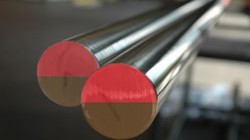Nitronic 50 / 60
Characteristics of NITRONIC 50
- NITRONIC 50 stainless steel is useful in a myriad of industries, including marine, food processing, textiles, pulp and paper, nuclear fuel recycling, fertilizer, chemical, petrochemical, and petroleum.
- The combination of high strength and superior corrosion resistance makes this alloy suitable for making components such as heat exchanger components, boat and pump shafting, marine hardware, screens and wire cloth, chains, cables, fasteners, valves and fittings, pumps, photographic equipment and springs.
- Useful in downhole rigging due to better corrosion and double the yield strength in annealed condition.
- Reduced cross sections thanks to better corrosion when compared to types 304, 316 and 17-4.
Characteristics of NITRONIC 60
- The all purpose metal exhibits good high temperature properties at temperatures up to 1800 ºF.
- The oxidation resistance of this material is comparable to Type 309 S.S., but much better than Type 304S.S.
- It is recognized for its galling and wear resistance. The inclusion of manganese and silicon provides this alloy a matrix to hinder fretting, galling and wear even under annealed condition.
- The material demonstrates higher strengths in the cold-worked condition, but still completely austenitic even after extreme cold-working. However, this condition does not improve the anti-galling properties as is normal for some stainless steels and carbon steels.
- The addition of nickel and chromium provides this alloy corrosion resistance comparable to 304 and 316 stainless steels, but with approximately double the yield strength.
- The annealed condition exhibits high mechanical strength, thus enabling the use of thinner sections, which in reduces weight and cost.
- This alloy is recommended for applications where galling problem takes place at below 1500 ºF.
- The high hardness of NITRONIC 60 in the annealed condition provides better cost advantage over other materials which require additional heat treating to improve their hardness.
- The corrosion resistance of this alloy is between that of types 304 and 316. The material exhibits superior low temperature impact.
- Although NITRONIC 60’s corrosion resistance is not as good as Type 316, the material offers better crevice corrosion resistance, stress corrosion cracking resistance, and chloride pitting resistance when compared to Type 316 under lab conditions.
- This material is an economical option to resist wear and galling when compared to cobalt or nickel based alloys.
- Carburization resistance of this material is superior. This alloy exhibits better ductility and strength after exposure when compared to Types 316L and 309 as illustrated below:

TOP
